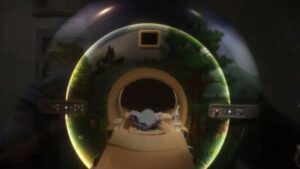
If you could visualize the passage of time, it might appear as looping ribbons of color, refracting light and shimmering in motion. Researchers at the University of Colorado Boulder have brought this vision closer to reality by creating “continuous space-time crystals,” a novel material that moves in a repetitive cycle through both space and time. These materials pulse, undulate, and flow in a rhythmic manner that appears never to stop.
Physicists once believed such behavior was confined to exotic quantum systems, beyond the reach of the tangible world. However, the Boulder researchers have demonstrated that time crystals can be formed using materials familiar in everyday life, specifically the liquid crystals found in smartphone displays. This discovery could revolutionize technology, influencing secure data storage and anti-counterfeiting measures.
From Simple Light to a World in Motion
In their study, scientists Hanqing Zhao and Ivan Smalyukh placed a thin layer of liquid crystals between two glass covers, using a dye that reacts to blue light with a wavelength of approximately 450 nm. Light wavelengths carry specific energy signatures, influencing molecular behavior.
When exposed to this light, the dye molecules change shape, affecting nearby liquid crystals. This interaction creates an unseen world that becomes visible under a microscope. The resulting patterns are colorful, complex stripes that swirl and pulse in a never-ending cycle. Remarkably, this system remains self-sustaining once initiated by light, without requiring additional energy.
“All it takes is shining a light, and this entire world of time crystals comes into bear,” said Smalyukh, a physics professor and fellow at the Renewable and Sustainable Energy Institute.
What it Means for Matter to Move With Time
Crystals typically form stable, solid structures with regular spatial patterns, like salt or diamonds. Time crystals, however, operate in both space and time, generating rhythmic motion independently of continuous external energy. This phenomenon breaks what physicists call “time symmetry,” akin to a clock that continues ticking without a battery.
Over the past decade, scientists have proven time crystals possible, though once deemed impossible. The Boulder team’s discovery marks the first time a time crystal has been observed in “soft matter,” visible even to the naked eye. “You can see them directly,” Zhao noted. “You don’t need a fancy detector. You can just watch it move.”
The Science Behind the Move
To understand this phenomenon, imagine light and molecules as dance partners. The light influences the dye molecules, which in turn twist the liquid crystal molecules, initiating motion waves that propagate through the material. These waves form “spatiotemporal solitons,” self-sustaining structures maintaining rhythm and order.
The scientists adjusted the light’s polarization and brightness to control the liquid crystals’ oscillation rate, producing stable, repeating waves that persisted for hours. Precise measurements confirmed the effect was genuine, not noise or vibration-related.
Using precise measurements of 77 millipascal-seconds of viscosity, a cell thickness of 3 micrometers, and a surface strength of 10⁻⁵ joules per square meter, they demonstrated how naturally time-based behavior stemmed from the physics of the materials themselves.
Technology Concealed in Beauty
Beyond their visual appeal, continuous space-time crystals (CSTCs) have significant potential applications. One is anti-counterfeiting, as each crystal develops a unique time-based pattern when illuminated, acting as a motion fingerprint. Future identification cards, currency, and official documents could feature secret “time watermarks” for authenticity verification.
A one-centimeter square sample requires less than 0.0002 grams of liquid crystal and a minuscule dye coating, making them cost-effective, scalable, and environmentally friendly. CSTCs could also revolutionize cryptography and data storage, encoding information through both space and time by varying oscillation rhythms.
This three-dimensional data storage approach could lead to new optical communication forms, where light serves as both carrier and code.
Rewriting the Laws of Physics
Previously, time crystals were primarily studied in quantum systems under extreme conditions, such as superconductors or Google’s Sycamore quantum computer. The Colorado team’s work shows similar phenomena can occur in standard environments at room temperature, challenging the notion that time crystalline order is exclusive to quantum systems.
Smalyukh suggests this discovery expands the native physics of understanding. “It suggests a deep relation between symmetry and time, not just theoretical, but also in the physical world around you.”
“It’s not just another material,” he said. “It’s a new way to think about matter and motion.”
Looking Ahead
The time crystal research by Zhao and Smalyukh, supported by the U.S. Department of Energy, could define new techniques and strategies for optical chips and quantum computing. The university has filed a patent application for future technologies based on CSTCs.
Given the ubiquity of liquid crystals, integrating CSTCs into existing systems could be straightforward, potentially enhancing phone screens, sensors, and communication systems. Smalyukh remarked, “I feel like having opened a door that was unknown.” When light interacts with liquid crystals, a new order emerges, creating a world that dances infinitely through time.
Practical Applications of the Research
The findings could lead to new technologies in aesthetics, art, science, and security. CSTCs may inspire anti-counterfeiting designs, ultra-secure encryption methods, and high-bandwidth data techniques. Encoding information through time could redefine optical communication and photonic computing.
More broadly, this discovery hints at time crystalline behavior in other natural systems, creating new dynamic and self-organizing materials that mimic life’s dance. Research findings are available in the journal Nature Materials.






